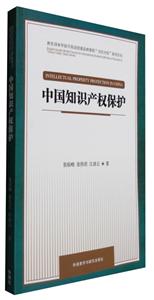-
>
考研英語背單詞20個(gè)詞根詞綴
-
>
西班牙語詞根寶典
-
>
美國K-12原版語文課本--初中·下(全12冊(cè))
-
>
流浪地球劉慈欣
-
>
西南聯(lián)大英文課 輕讀禮盒版
-
>
英語大書蟲世界經(jīng)典名譯典藏書系:中國人的精神 (英漢對(duì)照)(精選權(quán)威版本)
-
>
許淵沖譯唐詩三百首:漢文·英語
中國知識(shí)產(chǎn)權(quán)保護(hù) 版權(quán)信息
- ISBN:9787513570244
- 條形碼:9787513570244 ; 978-7-5135-7024-4
- 裝幀:一般膠版紙
- 冊(cè)數(shù):暫無
- 重量:暫無
- 所屬分類:>
中國知識(shí)產(chǎn)權(quán)保護(hù) 本書特色
《中國知識(shí)產(chǎn)權(quán)保護(hù)》系同濟(jì)大學(xué)“當(dāng)代中國叢書”系列教材之一,全部內(nèi)容采用英文撰寫并經(jīng)專家審閱。本書內(nèi)容權(quán)威詳實(shí),語言精煉地道,向讀者詳細(xì)介紹了中國知識(shí)產(chǎn)權(quán)保護(hù)的基本情況,可作為外國學(xué)生或讀者學(xué)習(xí)了解中國知識(shí)產(chǎn)權(quán)保護(hù)的教材使用。
中國知識(shí)產(chǎn)權(quán)保護(hù) 內(nèi)容簡介
The origin and primary aim of this work is to offer a textbook covering the basic information about Chinese intellectual property to foreign students with or without a legal background. With thesupport of Tongji University, we, the three authors of this textbook, have had the opportunity overthe past four years to offer a course named “Chinese Intellectual Property Protection”. It is one of the nine “General Courses Given in English”, which are open to all the international studentsat Tongji University, and seeks to present a general knowledge on the topic in China. During theteaching, we found it necessary to write a textbook which can meet the requirements of this course and help foreign students to get a better understanding of the landscape of Chinese intellectual property.
中國知識(shí)產(chǎn)權(quán)保護(hù) 目錄
1. An Introduction to Intellectual Property
1.1 The Concept oflntellectual Property
1.2 Main Branches oflntellectual Property
1.3 Reason to Protect Lntellectual Property
1.4 Main Features oflntellectual Property
2. An Introduction to Intellectual Property Legislation in China
2.1 HistoricaIBackground
2.2 Legislative Framework and Recent Trends
3. An Introduction to Intellectual Property Enforcement in China
3.1 Dualor ParalleISystem
3.2 JudiciaIEnforcement
3.3 Administrative Enforcement
Questions for Discussion
Chapter 2 Introduction to Chinese Patent Law
1. What Is a Patent
2. Patent Types and Terms ofProtectio
2.1 Three Types ofPatents
2.2 Invention
2.3 UtilityModel
2.4 Design
2.5 Terms ofthe Three Types ofPatent
3. PatentAuthority
3.1 Intemational Obligation to Offer NationalIP Services
3.2 Two-Tier Administrative Authority
3.3 State Intellectual Property Office (SIPO)
3.4 Local IP Office
4. Sources of Chinese Patent Law
4.1 Principle Legal Provisions Concerning Patent Law
4.2 Adoption of the Patent Law and the Amendments
4.3 Accession to IntemationaITreaties
Questions for Discussion
Chapter 3 Patent Eligibility and Patentability
1. Patent Eligibility
1.1 Consistency with Law, Morality and Public Interest
1.2 Patentable Subject Matter
1.3 Patent Eligibility ofComputer Software & Software-Related
Business Method
2. Patentab
2.1 Invention Patents and Utility Model Patents
2.2 DesignPatents
Questions for Discussion
Chapter 4 Proprietorship,Assignment and License of Pate nts
1. Relevant Players
1.1 Inventors or Designers
1.2 Patent Applicants
1.3 Patentees
1.4 Patent Licensees
1.5 Patent Assignees
2. Service Invention-Creation and Non-Service Invention-Creation
2.1 Servicelnvention-Creation.,
2.2 Non-Servicelnvention-Creatio
2.3 Contract Freedom to Fix the Nature of an Invention-Creation
2.4 Employee's Right to Claim Reward and Remuneration
3. Co-Ownership and Commissionlnventio
4. Patent Assignm ent
4.1 General
4.2 Formality
4.3 Assignment to a Foreigner
……
Chapter 5 Patent Prosecution and Invalidation in China
Chapter 6 Patent Infringement, Defense and Remedies
Chapter 7 Introduction to Copyright Law
Chapter 8 Ownership of Copyright
Chapter 9 Subject Matter of Copyright
Chapter 10 Rights of the Copyright Owners
Chapter 11 Rights Related to the Copyright
Chapter 12 The Terms of Copyright Protection
Chapter 13 Collective Management of Copyright
Chapter 14 Copyright Enforcement
Chapter 15 Trademark Registration in China
Chapter 16 Unfair Competition & Trademark Infringement
Chapter 17 How to Protect Well-Known Trademarks in China
Annex 1: Patent Law of the People's Republic of China (source: WIPO website)
Annex 2: Copyright Law of the People's Republic of China (source: WIPO website)
Annex 3: Trademark Law of the People's Republic of China (source: WIPO website)
中國知識(shí)產(chǎn)權(quán)保護(hù) 節(jié)選
《中國知識(shí)產(chǎn)權(quán)保護(hù)》: 2.3 Description According to Art.26, Para.3 of the Patent Act, the description must set forth the invention or utility modelin a manner sufficiently clear and complete so as to enable "a person skilled in the relevant field of technology" to carry it out. 2.3.1 A Person Skilled in the Art "A person skilled in the relevant field of technology" is largely consistent with the notions of "a person skilled in the art" or "a person in the art" or "a person holding/having ordinary skill in the art (PHOSITA)" in foreign laws and international conventions.The State IP Office's Guidelines for Patent Examination point out that "person skilled in the art" is a fictional person who is considered to have the normal skills and knowledge in a particular technical field, however, without being a genius. 2.3.2 Requirement of "Sufficiently Clear and Complete" "Sufficiently clear and complete" means the description must disclose the invention or utility model in a manner that enables a person skilled in the art to carry out the invention or utility model depending merely on the description,without further creative efforts of his/her own.The applicant must clearly describe the subject matter of the invention-creation, i.e., the technical problem the invention or utility model aims to solve,the technical solution adopted to solve this problem, and the advantageous effects of the invention or utility model. Meanwhile, the expression of the description must be precise, without ambiguity or equivocation. As to the completeness requirement, the description must include all the technical contents that are necessary for understanding and carrying out the invention or utility model. Actually, the arrangement ofthe form and content of the description (see below) is sort of tool to have the drafter met the requirement of completeness.The requirement of clarity and completeness also request that the description of the invention or utility model must use standard terms and be in clear wording, and must not contain such references to the claims as: "as described in the claim... ", nor does it contain commercial advertising. ……
- >
唐代進(jìn)士錄
- >
小考拉的故事-套裝共3冊(cè)
- >
史學(xué)評(píng)論
- >
莉莉和章魚
- >
伊索寓言-世界文學(xué)名著典藏-全譯本
- >
月亮虎
- >
中國歷史的瞬間
- >
【精裝繪本】畫給孩子的中國神話
















